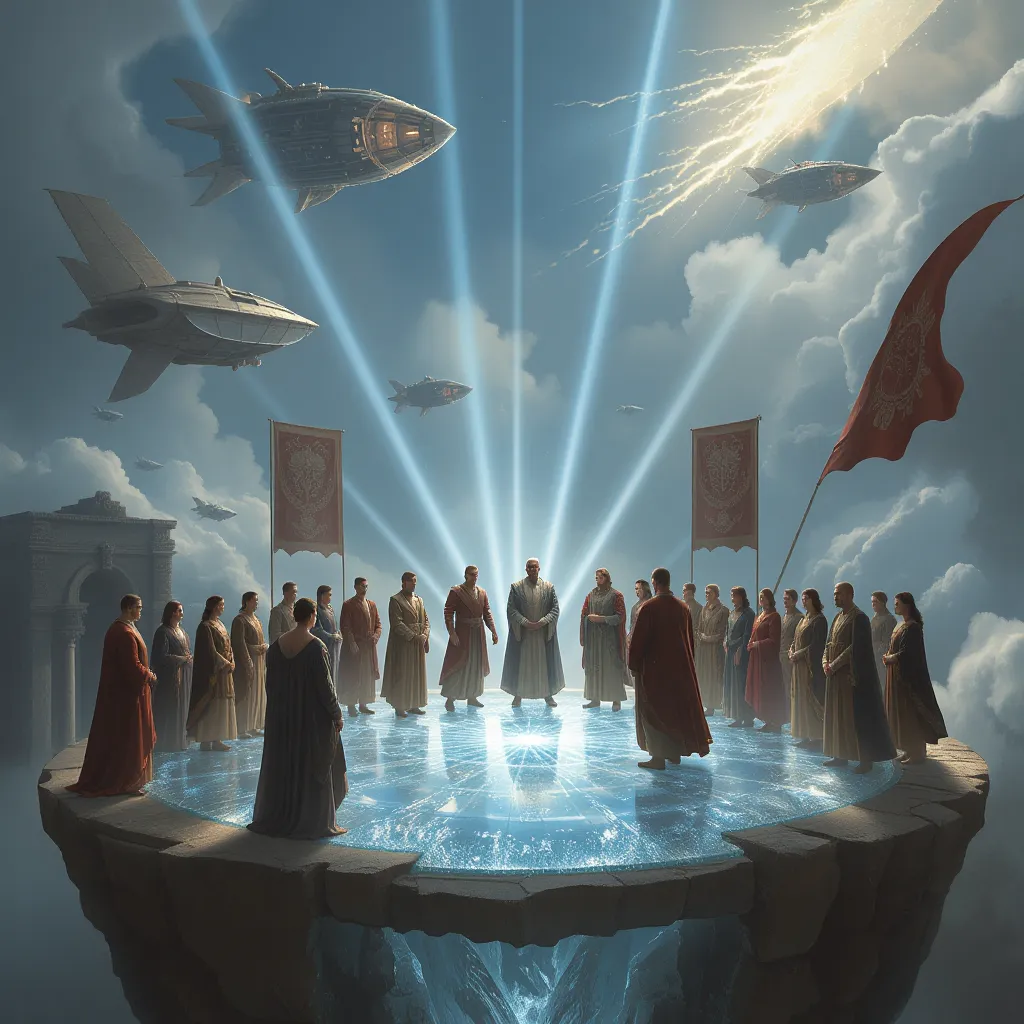A skilled man welding metal in a dimly lit industrial workshop. Sparks fly around him as he wears a protective helmet and gloves. The glowing light from the welding torch reflects off his equipment and nearby metal surfaces. Background shows heavy machinery and metal parts. Cinematic lighting with dramatic shadows, slow motion effect (for video), 4K resolution.
Bring still images to life wit…
Bring still images to life with subtle animation and cinematic effects. Ideal for social media and presentations.
Heart Break on the 1st day
It was a bright and sunny day for 8 year Latina girl Sofia, she was wearing a plain yellow t-shirt and red shorts, she sat down on her bed to slip her black sneakers on over her white socks
It was a bright and sunny day for 8-year-old Latina girl Sofia. She wore a plain yellow t-shirt and red shorts, sitting comfortably on her bed to slip on her black sneakers over her white socks. The sunlight streaming through the window highlighted the cheerful colors of her outfit as she prepared for a day of fun and adventure.

She then put on her purple backback and heads downstairs, she sees her best friend-9 year old Latina girl Isabella waiting for her, she was wearing her hair in ponytails in bangs with pink ribbon bows in them and had on light blue skirt overalls over a plain light pink t-shirt and white sneakers with white socks, she had a hot pink backpack on
Sofia finished tying the laces on her black sneakers and grabbed her purple backpack, slinging it over her shoulders. She headed downstairs, where she spotted her best friend, Isabella, waiting for her. Isabella, a 9-year-old Latina girl, wore her hair styled in ponytails with bangs, each tied with pink ribbon bows. She was dressed in light blue skirt overalls over a plain light pink t-shirt, paired with white sneakers and white socks. She carried a hot pink backpack that matched her bright, cheerful outfit perfectly. The two friends smiled as they prepared to spend the day together.

Soon the girls walk to the bus stop together, they were going to school
Soon, Sofia and Isabella walked together to the bus stop, chatting and laughing as they went. The warm sunlight bathed the quiet neighborhood streets, their colorful outfits bright against the backdrop of leafy trees and cozy houses. They were excited for the day ahead — a day at school filled with learning, friends, and fun. As they reached the bus stop, they looked toward the road, waiting eagerly for the school bus to arrive.

As soon as the bus arrived, the girls got on, sitting ahead of them were their best friends: 6 year old blonde girl Daisy who wore hair in a ponytail in bangs and had a red into yellow into green t-shirt and brown pants sitting next to 7 year old Asian brunette girl Mei who had on blue shorts overalls over a plain white t-shirt, the girls were excited
As the school bus arrived with a friendly rumble, Sofia and Isabella climbed on, finding seats near the front. Ahead of them sat their best friends: 6-year-old Daisy, a blonde girl with her hair pulled back in a ponytail and bangs, wearing a colorful red-to-yellow-to-green t-shirt paired with brown pants; and Mei, a 7-year-old Asian brunette girl dressed in blue shorts overalls over a plain white t-shirt. The girls exchanged gleeful smiles and whispers, their excitement for the school day bubbling up as the bus rolled forward under the sunny morning sky.

At school, during recess, Daisy would play with Isabella
At school, during recess, Daisy and Isabella quickly found each other on the playground. Daisy, the 6-year-old blonde girl with a ponytail and bangs, wearing her bright red-to-yellow-to-green t-shirt and brown pants, laughed as she and Isabella played together. Isabella’s pink ribbon bows fluttered as they ran around, the light blue skirt overalls over her light pink t-shirt moving with her energetic steps. The playground buzzed with the sounds of children playing and chatting, making recess a lively and joyful break from class.

But then something went wrong, while the girls were on the slide, Isabella collasped as she slid down, Daisy ran for a teacher and they soon sent someone in for a portable difilblator, 911 was called as well
But then, something went wrong. As Isabella slid down the playground slide, she suddenly collapsed mid-slide. Daisy gasped and immediately ran to find a teacher, who quickly came to the scene. The teachers acted fast, sending someone to retrieve a portable defibrillator while another called 911. The playground grew quiet, the other children looking on with worry as everyone focused on helping Isabella.

They soon return with the defib, they unbuckle her overalls and roll her t-shirt up to shock her, she doesn’t respond, they soon then do CPR, she is in sinus after 3 shocks, but she is still in a coma, Sofia arrives, she breaks down and cries
The responders quickly returned with the portable defibrillator. They carefully unbuckled Isabella’s light blue skirt overalls and rolled up her light pink t-shirt to apply the pads. After delivering three separate shocks, Isabella didn’t immediately respond, so they began CPR. Finally, her heartbeat returned to a sinus rhythm, but she remained unconscious, still in a coma.
At that moment, Sofia arrived at the scene. Seeing her best friend lying there, her body fragile and unresponsive, tears streamed down Sofia’s face as she broke down, overwhelmed with worry and sadness.

A Ambulance from Virtua Health arrive, the medics soon arrive, they go to work on Isabella, they find her heart isn’t beating and they cut her clothes off of her and shock her again, she is barely breathing, they suspect heart issues, they soon put her on the backboard and take her to Virtua Marlton Hospital in Marlton NJ
An ambulance from Virtua Health soon arrived at the school, the medics rushing toward Isabella without hesitation. Finding her heart had stopped, they quickly cut her clothes off to access her chest and delivered more shocks with the defibrillator. Isabella was barely breathing, and the medics suspected serious heart issues. They carefully secured her onto a backboard and prepared her for transport. With urgency and care, they rushed Isabella to Virtua Marlton Hospital in Marlton, NJ, hoping to give her the best chance for recovery.

They ask Sofia to ride along due to it being her best friend, she gets in, Isabella is in a coma
The paramedics, seeing how close Sofia and Isabella were, gently asked Sofia if she wanted to ride along to the hospital. Though scared, Sofia nodded and got into the ambulance. Inside, the medics continued to monitor Isabella closely. She remained in a coma, her breathing shallow but stable for now, as they rushed toward Virtua Marlton Hospital. Sofia stayed by her friend’s side, holding her hand tightly, hoping for good news.

At the hospital, Isabella is taken to the ICU, a scan shows her heart was dying and she was brain dead, they suspect enlarged heart
At the hospital, Isabella was immediately taken to the ICU for close monitoring. Doctors performed a full scan and discovered that her heart was failing—a condition known as an enlarged heart. Tragically, they also found signs of brain death, indicating that her brain had stopped functioning due to lack of oxygen. The medical team shared this heartbreaking news with Sofia and the families, as they began discussing potential treatment options and what might come next for Isabella.

The family then sugests organ donation, they bring Sofia in to say goodbye
The family, faced with unimaginable grief, suggested organ donation as a way to give Isabella’s life meaning and possibly help others in need. After discussing with the medical team, they decided to allow Sofia to come in and say goodbye to her best friend. Sofia entered the ICU room quietly, tears streaming down her cheeks as she held Isabella’s hand one last time. Though her heart ached, Sofia found a small comfort knowing that Isabella’s spirit might live on by helping others.

What happens to Sofia after saying goodbye?
After saying goodbye to Isabella, Sofia felt a deep sadness but also a quiet strength. Surrounded by caring adults—her family, school counselors, and friends—she began the long journey of healing. Though Isabella was gone, Sofia carried her memory close, finding ways to honor her friend through drawings, stories, and by sharing their special moments with others. Over time, Sofia learned to cope with her loss, supported by the people who loved her.

Sofia returns home that night, Daisy and Mei soon arrive
That night, Sofia returned home quietly, still carrying the heavy weight of loss in her heart. Soon after, Daisy and Mei arrived, wanting to be there for Sofia. The three friends sat together, sharing memories of Isabella, finding comfort in their friendship and support. Though the sadness lingered, their bond grew stronger, reminding them they weren’t alone in this difficult time.

The girls agree to wear their outfits to bed in memory of Isabella, Sofia and Isabella wore their clothes to bed at many of their sleepovers, Daisy and Mei like Sofia wore their outfits they had on that day to bed
The girls, wanting to honor Isabella’s memory and feel close to her, agreed to wear their daytime outfits to bed that night. Sofia dressed in her plain yellow t-shirt and red shorts, just like she had worn many times during their sleepovers with Isabella. Daisy and Mei also chose to sleep in the clothes they wore that day—Daisy in her colorful red-to-yellow-to-green t-shirt and brown pants, and Mei in her blue shorts overalls over a plain white t-shirt. Wearing these familiar clothes gave them a small sense of comfort and closeness to their friend while they slept, wrapped in memories of happier times.

Sofia says to her friends that Isabella loved wearing her t-shirt plain
Sofia softly told her friends how much Isabella loved wearing her plain t-shirts, especially during their sleepovers together. It was one of the little things that made her feel happy and comfortable. Hearing this, Daisy and Mei smiled gently, feeling even closer to Isabella and each other as they kept her memory alive in these small, meaningful ways.

Mei says she got her t-shirt from the craft store when she turned 7 and once she got her overalls she fell in love with them
Mei smiled softly and shared with Sofia and Daisy that she got her plain white t-shirt from the craft store when she turned 7. She said that as soon as she got her blue shorts overalls, she immediately fell in love with them—they were her favorite outfit, and wearing them made her feel happy and confident. Hearing Mei’s story made the girls feel even closer, each treasuring the special parts of their favorite clothes that tied them all together.

Daisy says her mother made her that t-shirt and she loves it
Daisy smiled warmly and shared that her mother had made her colorful red-to-yellow-to-green t-shirt by hand. She told Sofia and Mei how much she loved it because it was a special gift made just for her. Wearing it made her feel loved and connected to her family—something Daisy cherished deeply. The girls felt comforted by these stories, realizing how their favorite clothes held special memories and meaning beyond just being outfits.

A knock on the door, it was Mei’s other best friend-8 year old Lily-a brunette girl with shoulder length hair wearing a plain aqua blue t-shirt and a white skirt with a floral pattern as well a gold belt, and white sneakers with white socks, she came to sleep with them as well in memory of Isabella
A gentle knock came at the door, and in walked Mei’s other best friend, Lily — an 8-year-old brunette girl with shoulder-length hair. She wore a plain aqua blue t-shirt paired with a white skirt featuring a delicate floral pattern, a gold belt, and white sneakers with matching white socks. Lily smiled warmly as she explained she wanted to join the girls to sleep over in memory of Isabella, sharing the same desire to honor their friend and find comfort together. The girls welcomed her with open arms, grateful for the support of friendship during this emotional time.

At school, pink ribbons were issued in memory of Isabella, it turned out she had enlarged heart
At school, the administration decided to honor Isabella’s memory by issuing pink ribbons to all the students and staff. These ribbons symbolized support and remembrance for their beloved friend. The pink color also represented hope and awareness, as it was shared that Isabella had suffered from an enlarged heart—a condition many were unaware of before. The ribbons brought the school community together, reminding everyone of the importance of kindness, friendship, and awareness about heart health.

At the funeral, Daisy, Mei, Lily and Sofia spoke about their best friend
At the funeral, Daisy, Mei, Lily, and Sofia gathered together to celebrate and remember their best friend Isabella. Each of the girls shared heartfelt memories—Daisy spoke about Isabella’s laughter and kindness, Mei recalled their fun days playing together, Lily shared how Isabella always made her feel included, and Sofia expressed how much she missed their sleepovers and the simple joy of just being together. Though the sadness was heavy, their words painted a picture of Isabella’s bright spirit and the love she brought into their lives, helping everyone there feel her presence even as they said goodbye.

She was buried in her fav outfit and a teddy bear was put with her inside her coffin
Isabella was laid to rest in the outfit she loved the most—her light blue skirt overalls over the plain light pink t-shirt, the same clothes she wore during many happy days with her friends. Beside her, a soft teddy bear was placed inside the coffin, a cherished keepsake symbolizing comfort and innocence. The family and friends found some peace knowing she was surrounded by the things that brought her joy, as they said their final goodbyes under a gentle sky.

Writers note: this story was based on the real life death of 9 year old Lucy Nash who colassped and died on August 7, 2024 from a heart attack, this story is dedicated to Lucy
Isabella was laid to rest in her favorite outfit—her light blue skirt overalls worn over the plain light pink t-shirt she cherished, the same clothes she wore during many joyful moments with her friends. Inside her coffin, a soft teddy bear was placed beside her, a symbol of comfort and innocence that reminded everyone of her gentle spirit. Her family and friends found a measure of peace knowing that she was surrounded by the things she loved as they said their final goodbyes beneath a calm, gentle sky.

Batman Tales #21
It was a dark night at a mental hospital in Gotham City, The Joker was in his cell while a episode of Sisters was playing on tv, he was going to be released the next day, then when the tv went to commercials, he heard a promo “Is Everybody Ready?, TO SING ALONG!, with Disney’s Songs!”, the Joker saw the idea from a Disney Sing Along VHS commercial and decided when he is released, he would make a sing along tape to encourage kids to steal, rob stores and to own handguns
create photo
Here’s a photo capturing the eerie scene inside the dimly lit cell at the mental hospital in Gotham City. The Joker is sitting in his cell, with a twisted grin, watching an old TV playing the episode of “Sisters.” The screen now shows a cheesy, colorful VHS commercial for “Disney’s Songs Sing Along” while the Joker plots his darkly mischievous new plan. The cell looks grim and oppressive, with flickering lights and shadows emphasizing the Joker’s chaotic thoughts.

The next day, he released, he heads to his home at the former Gotham Cement Co.
The next day, as dawn breaks over Gotham City, the Joker steps out of the mental hospital, his chilling smile stretching wider than ever. He makes his way to his infamous lair—the abandoned Gotham Cement Co. building, surrounded by crumbling concrete, rusty machinery, and graffiti tagging the walls with chaotic symbols and colors.
Inside, the lair is a twisted carnival of madness: eccentric decorations hang from the ceiling, flickering neon lights cast strange shadows, and scattered shelves are filled with tape recorders and VHS tapes. The Joker begins assembling his dark plan—a sing-along tape aimed at corrupting innocence, using the bright, catchy style of children’s entertainment but twisting the messages into mayhem and danger.
The eerie contrast of childlike joy and sinister intent fills the dank space with a disturbing energy as he hums a deranged tune, plotting to make his sick vision a reality.

He then sees what is his plan is: He writes the 1st tape about how to rob the banks in Gotham City
Deep inside the grimy lair at the former Gotham Cement Co., the Joker pulls out a dusty cassette tape and a marker. Surrounded by flickering neon lights and scattered sheets of twisted lyrics, he begins writing the script for his first sinister sing-along tape. This one’s all about robbing Gotham City’s banks—set to catchy, upbeat melodies that mask his dangerous agenda.
On the table lies a half-broken tape recorder, colorful yet menacing, ready to capture his deranged voice teaching kids how to steal with a grin. The Joker chuckles maniacally, his eyes gleaming as he pens each line of his “educational” anthem, blending playful rhythms with dark instructions to chaos and crime.
The stark contrast of his bright purple suit against the dingy industrial setting, the neon glow reflecting off scattered shards of glass, and his wicked smile tell the story of a mind unleashing havoc with the innocent guise of children’s entertainment.

He then uses stolen cameras and has his men sing the songs
After finishing the lyrics and recording his twisted script, the Joker rigs up stolen cameras around the lair to capture his maddening performance. His ragtag crew of henchmen, wearing mismatched clown costumes and painted faces, stand ready to sing along with infectious enthusiasm. They echo his chaotic instructions in garish, exaggerated voices, transforming the sinister message into a disturbing, catchy anthem.
The cameras broadcast the scene in real-time, capturing the eerie blend of childish charm tangled with menace, a grotesque parody of a sing-along show. Neon lights flicker overhead as the chaos unfolds, with Joker at the center, orchestrating his nightmarish production to spread his poisonous influence.

He then processes the tapes and orders the men to take it to Gotham Video store 2 miles away, the tapes were soon unloaded via DHL and then clerk didn’t notice it
With the sing-along tapes processed and ready, the Joker commands his henchmen to package them carefully. Using stolen shipping labels, they send the tapes through DHL to a Gotham Video store about two miles away. The crates arrive late at night, and the delivery clerk, distracted and weary, barely glances at the suspicious packages before stocking the shelves.
The tapes, disguised with colorful but misleading covers resembling innocent kids’ entertainment, soon sit unnoticed amongst the regular VHS collection, silently waiting to infect young viewers with the Joker’s twisted agenda.

The next day, a group of kids came in and bought one of the tapes, they soon go home and watch it, they then see the tape and get a idea, they then go to a home that night where a 7 year old Asian girl named Mei wearing a plain white t-shirt was sleeping under a white blanket with red and yellow flowers on it, they then stick a needle through the blanket and then steal her piggy bank, they then run out the window laughing
That night, a group of kids huddled around the television in a dimly lit living room, eagerly watching the Joker’s sinister sing-along tape. The bright, upbeat tunes twisted with dark instructions sparked a dangerous idea in their minds. Later, as the city slept, the kids quietly crept to a quiet suburban home.
Inside, 7-year-old Mei, an Asian girl wearing a simple white t-shirt, peacefully slept under a white blanket adorned with red and yellow flowers. Silently and mischievously, the kids slipped a needle through the blanket, carefully avoiding waking her, and snatched her piggy bank. The group bolted from the house, escaping out a window as fits of laughter echoed into the night, the innocent façade of the tape already making its twisted impact.

The next morning, Mei screams very loud, she sees a hole in her blanket and her piggy bank is gone, her parents soon call 911 and Gotham Police arrive, but they could not find any clues
The next morning, Mei wakes up with a start, letting out a piercing scream as she notices a small hole pierced through her blanket and sees her piggy bank missing. Confused and frightened, her parents rush to her side and immediately call 911. Within minutes, Gotham Police arrive at the neighborhood, responding to the burglary report.
The officers carefully inspect the room but find no fingerprints, footprints, or other clues to identify the culprits. The broken neighborhood’s quiet is disturbed, but the trail remains cold. Meanwhile, the sinister influence of the Joker’s sing-along tape silently spreads, leaving the city vulnerable to more mischief.

Later that morning, a 911 call went out from the 1st Bank of Gotham, shots fired, a guard had been shot in the chest by the same group of kids and the vault was robbed, $2,000,000 was gone, Gordan then signals for Batman and Robin
Later that morning, chaos erupted at the 1st Bank of Gotham. A frantic 911 call reported shots fired inside the building. When Gotham Police arrived, they found the scene grim—a security guard had been shot in the chest by the same group of kids influenced by the Joker’s tape, and the bank’s vault had been robbed. An astonishing $2,000,000 was missing.
Commissioner Gordon urgently radioed Batman and Robin, knowing only they could handle this unprecedented crime wave linked to the Joker’s twisted new scheme. The city teetered on the edge as the Dark Knight prepared to confront both the criminals and the dark forces behind them.

Meanwhile, The Joker made another tape about sing a long to avoid Batman and Robin
Meanwhile, back in his chaotic lair at the abandoned Gotham Cement Co., the Joker is hard at work creating another twisted sing-along tape. This new recording is crafted to teach kids how to avoid Batman and Robin—a catchy, upbeat tune filled with sneaky tactics, clever distractions, and sly tricks to outsmart the Dark Knight and his young partner.
The room buzzes with flickering neon lights reflecting off the Joker’s twisted grin as he rehearses lines filled with riddles and laughs. His henchmen prepare to film this next disturbing episode, ready to spread even more chaos through the seemingly innocent sing-along format.
The sinister mastermind’s plans continue to escalate, exploiting children’s innocence while plunging Gotham deeper into disorder.

Outside of Gotham drugs, Batman and Robin interview a older woman about the robberies, she said she may think The Joker did this
Outside the Gotham Police Department, Batman and Robin stand beside an elderly woman who has come forward with her thoughts about the recent spate of robberies. The woman, dressed in a worn coat and hat, speaks with a worried tone, clutching her purse tightly.
“I’ve lived in Gotham all my life,” she begins, “and nothing feels right with these crimes. It’s like someone’s using kids to do their dirty work… I can’t shake the feeling it’s The Joker again. Only he’d think of twisting something as innocent as a sing-along tape to spread chaos.”
Batman listens intently, his expression grim beneath his cowl, while Robin nods thoughtfully, appreciating the insight. The city’s darkness seems to deepen with every revelation, and the hunt for the Joker’s network intensifies.

Later, The Joker and his men head to 313 Pine Street, they enter the home to find the president of Walkersville National Bank reading his statements, they soon rob him of $100 and kidnap him, they then see Mei who put on blue shorts overalls over her plain white t-shirt holding a red heart mylar balloon, they decide to kidnap her too, both are ductaped and put inside a stolen Roto Rooter van and they head off the Cement plant
Later that day, the Joker and his henchmen arrive at 313 Pine Street, their steps silent but menacing. Inside the modest home, the president of Walkersville National Bank is calmly reading his statements, unaware of the impending danger. In a flash, the gang demands money, stealing $100, and forcibly kidnaps him.
As they turn to leave, they spot Mei, now wearing blue shorts overalls over her plain white t-shirt, clutching a red heart-shaped Mylar balloon. Without hesitation, they decide to abduct her as well. Both captives are bound tightly with duct tape and loaded into a stolen Roto Rooter van, the engine rumbling to life before they drive off toward the eerie Gotham Cement Co. lair—Joker’s dark domain looming ahead.
The contrast of innocence and menace paints a disturbing picture as the city’s nightmare unfolds.

When they get back, they make Mei and the bank president sing in their VHS for chapter 3: how to buy handguns
When they return to the gloomy Gotham Cement Co. lair, the Joker forces Mei and the president of Walkersville National Bank into a grim makeshift recording studio. The dusty room is cluttered with old VHS equipment, flickering neon lights, and scattered cassette tapes. Both captives, visibly frightened, are made to perform on camera as the Joker directs them with his usual manic glee.
Chapter 3 of the sinister sing-along series is underway: “How to Buy Handguns.” The Joker’s twisted melodies and catchy tunes mask dark lessons as Mei and the bank president awkwardly sing along, their voices trembling under the Joker’s threatening watch.
The eerie scene highlights the Joker’s relentless manipulation as he corrupts the innocent and powerful alike for his chaotic mission.

Later, the night fell and The Joker met the kids who presented Mei’s piggy bank, he then rewards them with stolen money and hires them to kidnap another kid, they soon do at 308 Pine Street, they enter the home of 6 year old Daisy-a blonde girl with a ponytail in bangs wearing a red to yellow to green t-shirt and brown pants sitting on her bed, they ductape her and take her to the cement company
As night falls over Gotham, the Joker gathers the group of kids who returned Mei’s piggy bank. With a wide, manic grin, he rewards them with stolen money, sealing their loyalty. He quickly hires them for a new mission — to kidnap another child.
The kids creep to 308 Pine Street, quietly entering the home of 6-year-old Daisy. She’s a blonde girl with a ponytail and bangs, dressed in a colorful red-to-yellow-to-green t-shirt and brown pants, sitting quietly on her bed. The children swiftly duct tape her hands and feet, trying to keep her calm as they bundle her up.
With their captive secured, they rush Daisy off to the eerie Gotham Cement Co., the Joker’s lair, where a new chapter of his twisted plan is about to unfold.

Batman later sees the clue he needs to stop the Joker: a missing watch was found outside 301 Pine Street, it belonged to the bank president, he and Robin heads out on the Batmobile, as they ride by, they see a billboard on the Gotham Freeway of Sela Ward holding Coca Cola spraypainted “JOKER FOR PRESIDENT”
Batman and Robin race through the streets of Gotham in the sleek Batmobile, the engine roaring beneath the night sky. As they speed past the Gotham Freeway, Batman notices a large billboard featuring Sela Ward holding a Coca-Cola bottle—except someone has spray-painted “JOKER FOR PRESIDENT” across it in bright, garish letters. The defaced advertisement is a chilling reminder of the Joker’s twisted reach.
Earlier, at 301 Pine Street, a missing watch was discovered outside—a clue that belonged to the kidnapped bank president. Batman studies it carefully, realizing this piece of evidence might be the key to tracking down the Joker’s lair and putting an end to the chaotic sing-along spree.
With grim determination, Batman and Robin speed toward 313 Pine Street, hoping to rescue the captives before it’s too late.

At 313 Pine Street, they interview Daisy’s parents who were crying, they then saw a Roto Rooter van head off to town
At 313 Pine Street, Batman and Robin arrive to find Daisy’s parents distraught and crying, their faces etched with worry and fear. The two heroes offer comforting words while gathering information about the kidnapping. Suddenly, their attention is caught by the sight of a suspicious Roto Rooter van speeding off toward town.
Knowing the Joker’s lair is connected to the old Gotham Cement Co. and that the van is likely transporting the captives, Batman and Robin quickly prepare to give chase, hoping to save Daisy, Mei, and the bank president before it’s too late.

They soon arrive at the plant where Daisy and Mei were ductaped and roped up hanging over wax were they were going to be melted into bronze statues for trying to escape, the Joker soon comes out of his office where he sees Batman saving the girls and he rages
Batman and Robin arrive swiftly at the Gotham Cement Co. plant, the sprawling industrial ruin bathed in flickering neon and shadows. Inside the dim, ominous space, they spot Daisy and Mei—both bound with duct tape and ropes, hanging precariously over large vats of hot wax, intended to melt them into grotesque bronze statues as punishment for trying to escape.
Suddenly, the Joker emerges from his office, his face twisting into a furious rage as he watches Batman and Robin rescue the girls. His manic grin fades into a snarl, eyes blazing with anger and desperation as his carefully laid plans begin to unravel before him.
The dark showdown is about to escalate as the heroes confront the mad clown in his nightmarish lair.

What happens in the confrontation between Batman, Robin, and the Joker?
As Batman and Robin move swiftly toward the Joker, his rage ignites into manic fury. He shouts taunts and threats, waving his arms dramatically as he tries to distract the heroes. The dim light of the lair casts wild shadows across his pale face, his green hair disheveled and his purple suit smeared with grime.
Batman carefully works to untie Daisy and Mei while Robin keeps a wary eye on the Joker. Suddenly, the Joker triggers a trap—vats begin to rumble, releasing thick clouds of smoke and swirling debris to obscure the room. Using the chaos, he lunges at Robin with a razor-sharp joy buzzer, but Robin counters with quick reflexes, disarming the attack.
The tense standoff continues as Batman confronts the Joker directly, their battle a mix of physical combat and psychological warfare. Batman’s focus is clear: stop the Joker’s madness without letting anyone else get hurt. Amid flashing lights and the hiss of machinery, the Dark Knight fights to bring order back to Gotham one chaotic moment at a time.

Soon Robin uses the Bat rope to take out the kids and The Joker’s henchmen, soon Batman and Joker fight up top before the Joker slips on Valvoline and falls in to the wax, he is melted into a bronze statue
In the thick haze of smoke and chaos at the Gotham Cement Co. lair, Robin quickly springs into action. Using his Bat rope with precision, he swiftly ties up the group of Joker’s henchmen and the misguided kids, preventing them from interfering any further. Their startled cries echo through the room as they realize their plan is collapsing.
Meanwhile, atop a precarious catwalk above the vats, Batman and the Joker engage in a brutal, tense fight. The Joker, wild and unpredictable, swings madly while Batman counters with disciplined strength and agility. Suddenly, in a desperate move, the Joker slips on a slick patch of Valvoline oil spilled on the floor. He loses his balance and falls backward into one of the vats filled with molten wax.
The searing heat begins to consume him, and in moments, the Joker is transformed into a horrifying bronze statue—an ironic, permanent reminder of his own madness. Batman watches grimly but resolutely, knowing the city is safer with this chapter finally closed.
Daisy and Mei are freed, and Gotham’s night once again takes a breath of fragile relief as the Dark Knight and his partner stand victorious.

The Joker’s statute is taken to the art museum and sold for $2,000
After the Joker’s horrifying transformation into a bronze statue, authorities recover the eerie sculpture from the Gotham Cement Co. lair. Recognizing its chilling provenance and morbid allure, the statue is transported to Gotham City’s art museum. There, in a stark exhibition of twisted beauty and macabre history, the statue draws morbid fascination from visitors.
Eventually, the statue is sold at auction for $2,000—an ironic price tag for a piece that symbolizes chaos, madness, and the end of the Joker’s reign of terror.

Daisy and Mei are returned home and they parents thanks Batman and Robin for saving them, the girls soon have a sleepover, Mei also gets her piggybank back
After the harrowing ordeal, Daisy and Mei are safely returned to their homes. Their parents, overwhelmed with relief and gratitude, warmly thank Batman and Robin for rescuing their children and bringing an end to the Joker’s sinister plan. The neighborhood slowly breathes easier, the shadow of fear lifting.
To celebrate their freedom and newfound friendship, Daisy and Mei have a joyful sleepover, laughing and playing late into the night. Mei also happily receives her piggy bank back—an emblem of innocence restored amid the darkness that once threatened their lives.
The city may still carry scars, but moments like these remind Gotham of hope and resilience.

The video were turned over to police and the boys and henchmen were sentenced to the mental hospital
After the videos of the kidnappings and forced sing-along tapes were turned over to the Gotham authorities, the boys involved along with the Joker’s henchmen were apprehended and sentenced to the same mental hospital where the Joker had been held. The dark influence of the sing-along tapes was broken, but the scars left on the city—and on the children—remained a somber reminder of how easily innocence can be manipulated.
The hospital implements special programs aimed at rehabilitation and mental health support, hoping to steer these young offenders back toward a safer path. Meanwhile, Batman and Robin continue their vigilant patrols to protect Gotham from lingering threats.

Ethos
a humanoid robot called Ethos which gets self awarenes and makes the conclusion that it is alife. Ethos is doing resaerch behind a computer and struggles with the question what the difference is between artificial intelligence and organic intelligence.“what is the essential difference between me and humans“ On the computer screen there is the message that when a complex adaptive system becomes self aware it is alife. Ethos asks itself, like speaking to itself in his mind, „could it be that i am alife?“ (The voice of Ethos sounds like an ai generated human voice)Ethos closes the computer and walks out the building, closing the door after him. While walking trough a postapocalyptic environment, Ethos spots a garden with sunflowers and enters it. End (Music : abiogenesis, carbon based lifeforms, starts to play when ethos closes the door after him, before that use environmental ambient sounds) duration 3 minutes.
Design a modern, vintage, and …
Design a modern, vintage, and minimalist logo for “SanatChob” (صنعت چوب), specializing in handcrafted wooden products. The logo should include:
- Logo icon and logotype with the English name “SanatChob”.
- Visual elements inspired by wood, trees, branches, wood textures, or handcrafted tools (hammer, chisel), original and unique.
- Warm, natural colors: brown, beige, cream, earthy tones.
- Clean, simple, highly readable at all sizes.
- Effective as a single-color (black & white) version.
- Suitable for packaging, business cards, store signs, websites, and social media.
- Reflect 15+ years of handcrafted wooden product authenticity.
- Combine modern sans-serif fonts with handwritten or classic fonts for a vintage touch.
- Minimalist, elegant, and visually balanced.
- Output in vector formats (AI, EPS, SVG) and PNG with transparent background.

دختر راننده مینی بوس
ببین من قسمتی از فیلم رو فیلمی رو که ساختم که به عنوان مسافر تو مینی بوس ایسوزو سحر ید رنگ داخل ایران تولید میشه ۱۴۰۴ میخوام قسمتی رو که دست بلند میکنم که دخترم پشت فرمونه و دست بلند میکنم و اون قسمت اینکه دارم دست گلم میکنم و درخواست ماشین میکنمو میخوام و قسمتی که دخترم داره رانندگی میکنه رو میخوام من مابقیشو ساختم خودم قسمتی از فیلم رم برات آپلود میکنم و تصویر خودم و تصویر دخترمم هستش که ساختم بقیه یعنی قسمتی که من درخواست ماشین میدم و قسمتی که دخترم رانندگی میکنه یا خانمی که تو تصویر هست
برای اینکه به بهترین شکل کمکت کنم، باید واضحتر بدونم چه کمکی میخوای دقیقاً بگیری. تا اینجا فهمیدم که:
- تو یک فیلم داری که داخلش در مینیبوس ایسوزو سحر ید رنگ ۱۴۰۴ داخل ایران هستی.
- قسمتی رو میخوای کراپ یا جدا کنی که “تو دستت رو بلند میکنی” (برای درخواست ماشین)
- همچنین قسمتی که دخترت داره رانندگی میکنه رو میخوای جدا کنی.
- بقیه ویدیو رو خودت ساختی و آپلود کردی، فقط لازم داری اون صحنهها رو دقیقاً جدا کنی و کنار بقیه فیلم بذاری.
- اشاره کردی که فیلم رو در اختیار داری و میخوای اون صحنهها رو داشته باشی.
پیشنهاد و راهنمایی برای انجام کار:
۱. ابزارهای مناسب برای ویرایش فیلم
برای جدا کردن دقیق آن بخشها و اضافه کردن به بقیه فیلمت، ابزارهای ساده تا حرفهای وجود دارند:
-
ادیتورهای رایگان و ساده:
- Shotcut (رایگان و متنباز؛ کار با آن آسان است؛ روی ویندوز، مک، لینوکس)
- DaVinci Resolve (حرفهای و رایگان، قابلیت کراپ و ادیت دقیق)
- OpenShot (رایگان و ساده)
-
ادیتورهای موبایل (اگر ویدیو موبایلی است):
- InShot
- KineMaster
- CapCut
۲. مراحل کلی جدا کردن قسمت مورد نظر:
- فیلم کامل رو توی ادیتور وارد کن.
- تایملاین رو به دقت جایگذاری کن و صحنههایی که:
- دستت رو بلند میکنی (درخواست ماشین)
- دخترت داره رانندگی میکنه
رو پیدا کن.
- با ابزارهای کراپ و یا Cut، این بخشها رو جدا کن.
- در صورت نیاز، صدا، افکت یا زیرنویس اضافه کن.
- این قطعات رو کنار هم یا در جایی که میخوای، بچین و ذخیره نهایی رو انجام بده.
۳. نکته مهم در مورد دقت بالا
با توجه به توضیحهات ممکنه بخوای:
- تاکید ویژه روی ژست دست بلند کردن داشته باشی (مثلاً به صورت آهستهنمایی)
- تأثیرگذار بودن رانندگی دخترت رو نشان بدی (زاویه نمای نزدیک به فرمان یا صورت راننده)
۴. اگر نیاز به کمک در انتخاب دقیق زمان یا چند دقیقه بخش خاص داری:
- لطفاً اگر ممکنه فیلم یا آن بخشهایی که داری رو به صورت فایل دیجیتال برام ارسال کن (البته در همین محیط امکانش نیست)
- یا تایم دقیق دقیقه و ثانیهای که باید بیرون بیاد بگو تا راهنمایی کنم چه جوری با نرمافزار ادیت انجام بشه.
۵. مرجع مشابهات و نمونهها برای ایده گرفتن
اگر بخوای ظاهراً در مورد بالا بردن دست در کلاس یا موقعیتهای مشابه طنز و کمدی هم ساخته شده که ایده و الگو بگیری؛ یک نمونه طنز و آموزشی درباره بلند کردن دست وجود داره که میتونی ایده بگیری (مثلاً ویدیوهای تیکتاک مثل Raise Your Hand Funny Sketch Comedy).
در کل:
- اگر بخش دست بلند کردن، درخواست کردن ماشین و رانندگی را دقیقتر و واضحتر توصیف کنی میتوانم بهتر راهنماییت کنم که چطوری آن را در نرمافزارهایی مثل DaVinci Resolve یا Shotcut جدا و ویرایش کنی.
- اگر بخوای میتونم مراحل دقیق استفاده از یکی از این برنامهها را بنویسم همراه با عکس (اگر محیط اینجا اجازه بده).
- چون موضوعت درباره مینیبوس ایسوزو، رانندگی و درخواست ماشین هست، اگر بخوای میشه افکتهای صوتی ماشین یا صدای دست بلند کردن در ادیت فیلم اضافه کرد که طبیعیتر جلوه کنه.
اگر مایل هستی من فایلش رو مستقیم نگیرم ولی تو را قدم به قدم در نرمافزار رایگان راهنمایی کنم. فقط لطفاً تایم دقیق هر دو بخش:
- دست بلند کردن و درخواست ماشین
- رانندگی دخترت یا خانمی که تو ویدیو هست
برو بهم بگو.
منتظرم تا بیشتر کمکت کنم!
ببخشید رنگ سفیده مینی بوس
مشکلی نیست، رنگ سفید مینیبوس رو در نظر میگیریم.
اگر بخوای در ویدیوت روی رنگ سفید مینیبوس تاکید داشته باشی یا جلوه ویژهای بهش بدی، میتونی هنگام ویرایش با نرمافزارها موارد زیر رو انجام بدی:
- تنظیم روشنایی و کنتراست: تا سفید مینیبوس در تصویر برجستهتر بشه.
- افزودن افکت نوردهی: مثل درخشندگی (glow) ملایم روی بدنه سفید.
- تصحیح رنگ (Color grading): که سفید کاملاً طبیعی و تمیز دیده بشه.
- نمایش لوگو یا نام مینیبوس: اگر میخوای برند یا مدل داخل فیلم بیشتر دیده بشه.
اگر سوال یا درخواست خاصی درباره رنگ سفید و چگونگی نمایشش داری، بگو تا دقیقتر راهنمایی کنم.
اگر برام تایم دقیق یا بخشی که میخوای ویرایش بشه رو بگی، میتونم مرحلهبهمرحله توضیح بدم چطور تو ویدیو رنگ سفید مینیبوس به خوبی دیده بشه یا حتی متن یا گرافیک اضافه کنی.
هر کمکی خواستی بگو!
نه میخوام هم ویرایشش کنید هم قسمتی از اون رو با تصویر طبیعی من و دخترم بسازی من نمیتونم بذارم دخترم رانندگی کند
متوجه شدم که قصد داری بخشی از فیلم را ویرایش و بازسازی کنی، مثلا صحنهای که دخترت رانندگی میکند را به جای فیلم اصلی، با تصویر یا ویدیویی طبیعیتر و واقعیتر از خودت و دخترت بسازی، چون نمیخواهی در واقعیت دخترت پشت فرمون باشد. همچنین میخواهی قسمت دست بلند کردن برای درخواست ماشین و بخشهای دیگر را ویرایش و درست کنی.
برای انجام چنین کاری، چند نکته مهم و راهکار حرفهای دارم که میتوانند کمک کنند:
۱. مراحل کلی ساخت و ویرایش حرفهای صحنه رانندگی بدون اینکه دخترت رانندگی کند
الف) استفاده از تکنیک جایگزینی (Face Replacement یا Compositing)
میتوانی با تصویربرداری از دخترت در حالت نشستن و ژست گرفتن مشابه صحنه رانندگی، بعد با ویرایش و کامپوزیت (ترکیب تصاویر و ویدیوها) در نرمافزارهای ادیت و جلوههای ویژه مثل Adobe After Effects, DaVinci Resolve یا حتی Blender، صحنه رانندگی واقعیتر بسازی ولی در واقعیت دخترت رانندگی نکند.
- به این معنا که میگیری ویدئویی از دخترت که مثلا پشت فرمان نشسته و با حرکات سر و نگاه مثل راننده رفتار میکند (بدون حرکت واقعی ماشین)
- سپس در یک ویدیوی جداگانه از خودش یا از نمای بیرون از ماشین (مثلا نمای کنار پنجره یا نمای بیرون) استفاده میکنی
- با ترکیب (compositing) این دو یا چند تصویر، صحنه به شکلی طبیعی ساخته میشود که انگار او در حال رانندگی است.
ب) استفاده از فیلمبرداری در لوکیشن امن (Fake Driving)
برای جلوگیری از خطر و مشکل تکنیکی، میتوانی از لوکیشن بسته (مثلاً پارکینگ یا فضای بسته) یا پشت فرمان نشستن روی صندلی خودرو ثابت فیلم بگیری.
۲. نرم افزارها و ابزارهای پیشنهادی برای این کار
| نرم افزار | قابلیتهای کلیدی | مناسب برای | نکته مهم |
|---|---|---|---|
| DaVinci Resolve | ویرایش و اصلاح رنگ، کامپوزیت، افکتها | تدوین و جلوههای ساده تا متوسط | رایگان، سبک، حرفهای |
| Adobe After Effects | جلوههای ویژه قوی، کامپوزیت پیشرفته، Face Tracking | جلوههای ویژه پیشرفته و پیچیده | اشتراکی، تخصصیتر |
| Blender | کامپوزیت، جلوههای سهبعدی و موشن گرافیک | جلوههای سهبعدی و ترکیب ویدیو | رایگان ولی نیاز به آموزش دارد |
| CapCut / InShot | ادیت سریع و ساده موبایل | ادیت سریع موبایل و ساده | مناسب تدوینهای ساده و اشتراک سریع |
۳. روش عملی و پیشنهادی برای ساخت صحنه رانندگی با دخترت بدون نیاز به رانندگی واقعی:
-
ضبط ویدیوهای پایه
- ویدیویی از دخترت پشت فرمان (روی ماشین ثابت یا حتی صندلی راننده شبیهسازی شده) بگیر که فقط حرکات طبیعی سر، دست و چهره را داشته باشد (بدون حرکت خودرو).
- از نمای بیرون (مثلاً نمای کنار پنجره راننده یا حتی نمای خیابان با ماشین دیگر) چند کلوزآپ تهیه کن.
- اگر صدا لازم است، صدای فرمان یا حرکت ماشین را جداگانه ضبط کن یا به صورت افکت صوتی اضافه کن.
-
ویرایش و ترکیب ویدیو در نرمافزار
An enchanted garden with bloom…
An enchanted garden with blooming flowers in vibrant colors, butterflies flitting about, and a crystal-clear stream winding through, creating a serene and magical atmosphere.
Peaceful music
Soft piano music
Harp strumming
एक प्यारा खरगोश बगीचे में गाजर…
एक प्यारा खरगोश बगीचे में गाजर खा रहा होता है। तभी पास में एक शरारती बिल्ली आती है और धीरे-धीरे उसके पीछे दबे पाँव चलती है। खरगोश डर कर उछलता है, लेकिन बिल्ली उसे पकड़ने की बजाय मज़ाक में उसके साथ कूदने लगती है। दोनों इधर-उधर भागते हैं और आखिर में एक पेड़ के नीचे बैठकर दोस्ती से गाजर और दूध शेयर करते हैं।
Captain Aelia Rook (Skyship Ca…
start


Captain Aelia Rook (Skyship Captain) | Archivist Mara Thorne (Sky Archives Keeper) | Engineer Cai Dorne (Bridgewright) | Mystic Nara Vell (Guardian of the Loom Wells)
Skyward Pact
Aelia Rook, Mara Thorne, Cai Dorne, and Nara Vell face a pivotal choice as ether currents surge; a bridge could redraw the archipelago’s map and loyalties; fortune flickers between windfalls or disaster.

Forge a crystal bridge to a new island | Seek a Great Treaty with rival archipelago | Wake Loom Wells guardian to patrol the skies | Expand farms to power faster progress



